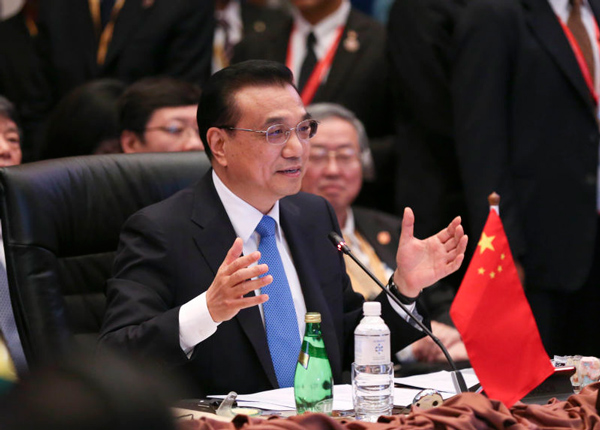
 |
|
Chinese Premier Li Keqiang addresses the 18th ASEAN-China summit in Kuala Lumpur, Malaysia, Nov 21, 2015.[Photo/Xinhua] |
A series of high-profile interactions between China and the Association of Southeast Asian Nations this month has sent a strong signal to the rest of the world: The two sides are making joint efforts to deepen cooperation and prevent outsiders from interfering in regional affairs.
Premier Li Keqiang attended the 19th ASEAN-China leaders' meeting and the 19th ASEAN-China, Japan and the Republic of Korea leaders' meeting in Vientiane, Laos, on Sept 7. China has played important roles in both mechanisms, which, over the years, have served as major channels for regional integration.
On Sept 11, the 13th China-ASEAN Expo opened in Nanning, capital of South China's Guangxi Zhuang autonomous region. The annual event has become a major platform for China and ASEAN member states to showcase the fruits of their cooperation, ink new business deals and discuss ways to deepen their relationships.
Such high-level interactions have not only helped strengthen China's good-neighborly ties with the 10-member regional bloc, they have also made the two sides more confident of their abilities and wisdom to properly handle their differences and contribute to regional peace and development.
Admittedly, relations between the two sides have been overshadowed by the recent disputes between China and some ASEAN member states in the South China Sea. Some in the West have even developed a tendency to portray the disputes as open discord between the two sides whenever a high-profile meeting is held between their leaders.
After an arbitral tribunal in The Hague ruled in favor of the Philippines in its dispute with China over the South China Sea in July, some vested interests thought the East Asia Summit meetings in Laos could be a perfect occasion to drum up anti-China sentiments again. However, those who harbored such feelings were disappointed because the leaders of China and ASEAN member states vowed to ease tensions in the South China Sea and deepen their cooperation.
The two sides have agreed, among other things, to set up a hotline so that their senior diplomats can assess and address emergencies at sea. They also issued a joint statement on the application of the Code for Unplanned Encounters at Sea, an international agreement reached in 2014 to reduce the chances of maritime incidents, in the South China Sea. These significant agreements will help enhance strategic trust between the two sides and help make the South China Sea truly peaceful and stable.
In his remarks addressing the 10+1 summit, Premier Li also talked about the prospect of a code of conduct, which the two sides have been negotiating for three years to pave the way for the implementation of the 2002 Declaration on the Conduct of Parties in the South China Sea. China has proposed a framework of COC to be completed before ASEAN Foreign Ministers Meeting in July next year.
Under the gaze of the rest of the world, China and ASEAN exercised strong political will and made concrete efforts to steer clear of the obstacles in their bilateral ties. As Premier Li said in Vientiane, regional prosperity and development hinges on peace and stability in the South China Sea. And lessons from other regions in the world that have encountered some turbulence show how important it is for regional players to maintain peace and stability at all times.
Asian countries should cherish the hard-won peaceful environment in the region, because it has been the basis of their economic development and social progress in recent years. The fruits of China-ASEAN relations in the past 25 years show healthy cooperation between the two sides has served as a cornerstone of regional development, and there is every reason for the two sides to build on this desirable momentum.
The author is deputy editor-in-chief of China Daily Asia Pacific.
jasmine@chinadailyhk.com
